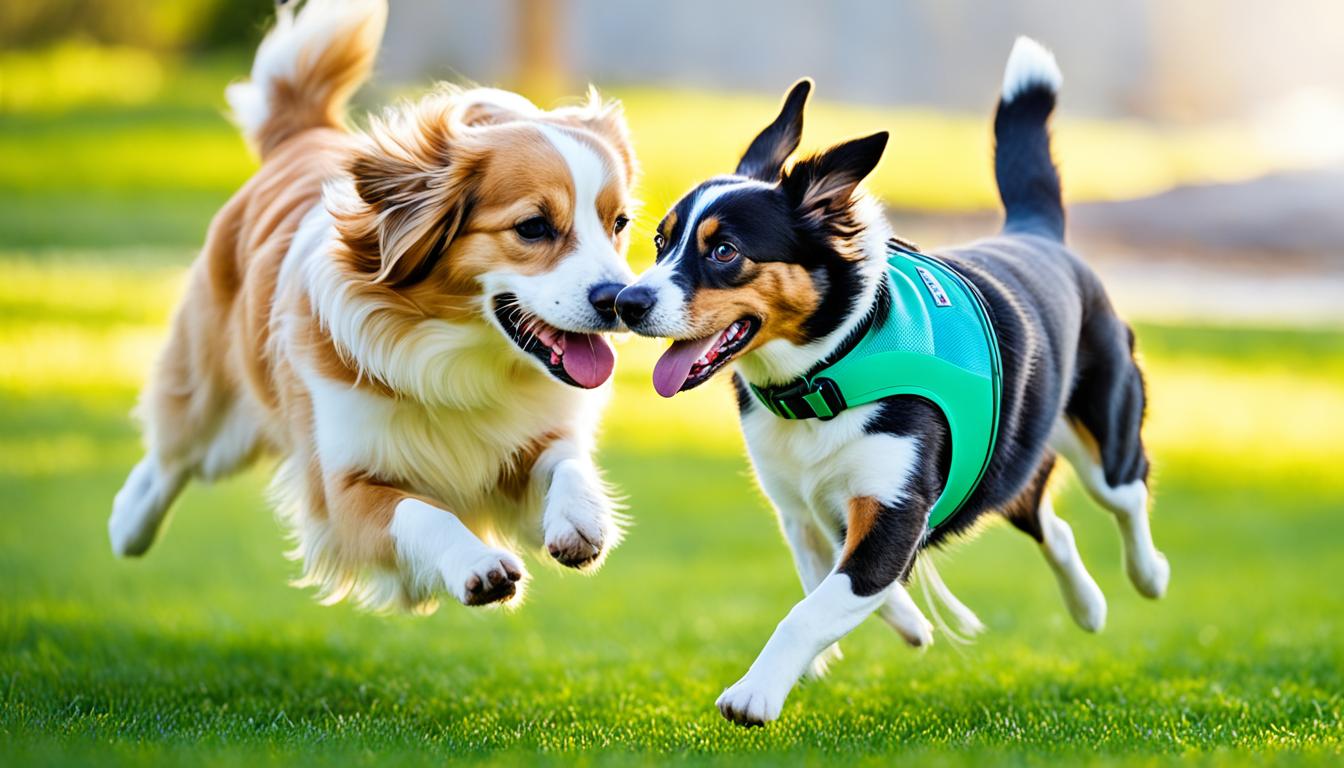The Benefits of Regular Play and Exercise for Pets!
At [Your Brand], we understand the importance of keeping pets healthy and happy. Regular play and exercise are key factors in maintaining the overall health and wellness of our beloved furry companions. Not only do these activities provide enjoyment and fun, but they also offer numerous benefits for their physical, mental, and emotional well-being.
Exercise plays a vital role in keeping pets fit and maintaining a healthy weight, reducing the risk of obesity-related health issues. It promotes a healthy digestive and circulatory system, lowers blood pressure, and builds muscle. Regular physical activity can also prevent behavioral problems arising from boredom and help pets maintain a happy and positive mood.
Different breeds have different exercise needs, which is why it’s crucial to consult with a veterinarian to create a tailored exercise plan for your pet. They can provide expert advice based on your pet’s specific requirements, ensuring their safety and well-being.
Key Takeaways:
- Regular play and exercise are essential for pets’ health and wellness.
- Exercise helps pets maintain a healthy weight and reduces the risk of obesity-related health issues.
- Physical activity promotes a healthy digestive and circulatory system, lowers blood pressure, and builds muscle.
- Regular play and exercise can prevent behavioral problems and contribute to a happy and positive mood.
- Consult with a veterinarian to create an exercise plan tailored to your pet’s specific needs.
Boosting Pet Health with Joyful Activities
Play is an essential component of maintaining the overall wellness of pets. It not only provides physical exercise but also promotes mental stimulation and emotional well-being. Engaging in interactive games with pets allows them to keep their minds sharp and encourages cognitive development. Activities such as hide and seek, puzzle treat games, and chasing toys can provide mental stimulation and entertainment for pets.
The Vital Role of Play in Pet Wellness
Regular play sessions with pets contribute to their improved mood and reduced stress levels. It helps alleviate boredom and prevents behavioral issues that may arise from a lack of mental stimulation. By engaging in joyful activities with their owners, pets form a stronger bond and develop a sense of trust and companionship.
Interactive Games for Mental Stimulation
Interactive games are a great way to provide mental stimulation for pets. These games challenge their problem-solving skills and keep their minds active. Puzzle treat games, where pets have to solve a puzzle to be rewarded with a treat, are particularly effective in engaging their mental faculties. Additionally, games such as hide and seek and chasing toys provide physical exercise while also stimulating their cognitive abilities.
Overall, incorporating play into the daily routine of pets is crucial for their health and wellness. It ensures they receive the physical exercise they need, keeps their minds sharp, and strengthens the bond between pets and their owners. By providing joyful activities for pets, we can contribute to their overall well-being and happiness.
Combating Pet Obesity Through Exercise Routines
Pet obesity is a growing concern that can lead to various health issues. Regular exercise is key to combating pet obesity and maintaining a healthy weight. By implementing exercise routines tailored to your pet’s needs, you can help them shed excess pounds and prevent related health problems, such as respiratory and joint issues.
Starting the exercise routine gently is essential, as it allows your pet to gradually adjust to the increased physical activity. Begin with shorter sessions and gradually increase the intensity and duration as your pet becomes more comfortable and fit.
Monitoring your pet’s weight is also crucial in combating obesity. Keep track of their weight regularly and adjust their exercise routine and diet accordingly to ensure steady and healthy weight reduction.
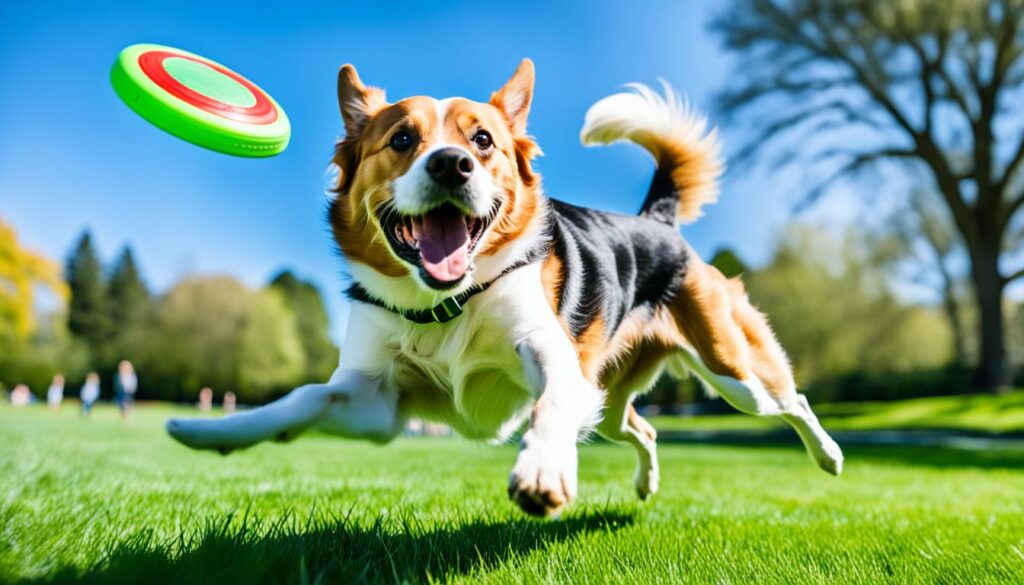
Consulting with a veterinarian is highly recommended when designing an exercise routine for your pet. They can provide valuable advice and guidance on appropriate exercise intensity and duration based on your pet’s age, breed, and overall health condition.
Additionally, it’s important to incorporate a variety of exercises into your pet’s routine to keep them engaged and motivated. A combination of aerobic activities, such as walking or jogging, and strength-building exercises, such as agility training or playing with toys, can help your pet burn calories, improve muscle tone, and promote overall fitness.
Exercise not only helps combat pet obesity but also provides mental stimulation and promotes a positive mood. Regular physical activity keeps pets happy, reduces anxiety and boredom, and enhances their overall well-being.
Sample Exercise Routine for a Dog
| Exercise Activity | Frequency | Duration |
|---|---|---|
| Brisk Walk | 5 times per week | 20-30 minutes |
| Fetch or Frisbee | 3 times per week | 10-15 minutes |
| Agility Training | 1-2 times per week | 15-20 minutes |
| Interactive Toy Play | As needed for mental stimulation | Varies |
Remember to always tailor the exercise routine to your pet’s specific needs, considering factors such as age, breed, and any pre-existing health conditions. Be patient and consistent with your pet’s exercise routine, and you’ll soon see the positive impact it has on their overall health and well-being.
Essential Pet Care Tips for a Thriving Companion
Taking care of a pet involves more than just providing love and attention. It requires a holistic approach to their health and well-being. Daily exercise and proper nutrition are key factors in ensuring your pet thrives and lives a happy, healthy life.
Daily Exercise Recommendations for Different Breeds
Exercise is essential for all pets, but different breeds have different exercise needs. Understanding the exercise requirements and energy levels of your pet’s breed is crucial to ensure their overall well-being. Consult with a veterinarian to determine the appropriate exercise routine for your pet.
Daily exercise provides numerous benefits for your pet, such as:
- Weight management: Regular exercise helps pets maintain a healthy weight, reducing the risk of obesity-related health issues.
- Improved cardiovascular health: Exercise promotes a healthy circulatory system by improving blood flow and reducing the risk of cardiovascular diseases.
- Enhanced muscle tone: Regular physical activity builds and strengthens muscles, improving your pet’s overall physique and agility.
- Mental stimulation: Physical exercise stimulates your pet’s mind, preventing boredom and associated behavioral problems.
Keep in mind that specific breeds may have special exercise considerations. For example, high-energy breeds, such as Border Collies and Siberian Huskies, may require more vigorous exercise routines, while smaller or brachycephalic breeds, like Pugs and Bulldogs, may need shorter, low-impact activities.
Note: It is important to always monitor your pet during exercise and provide plenty of water breaks to prevent exhaustion and dehydration.
Nutritional Considerations for an Active Pet
A balanced and nutritious diet is essential for your pet’s well-being, especially if they are active and require more energy. Consult with a veterinarian to determine the appropriate nutritional plan for your pet’s specific needs.
Consider the following nutritional tips for an active pet:
- High-quality pet food: Choose a reputable brand that provides essential nutrients and avoids unnecessary fillers or artificial ingredients.
- Proper portion control: Overfeeding can lead to obesity, while underfeeding can result in nutrient deficiencies. Follow portion guidelines based on your pet’s age, size, and activity level.
- Lean protein: Include lean protein sources, such as chicken, fish, or turkey, to support muscle development and repair.
- Healthy fats: Incorporate sources of omega-3 fatty acids, like fish oil, to promote a healthy coat, skin, and joint health.
- Wholesome carbohydrates: Choose complex carbohydrates, such as sweet potatoes or brown rice, for sustained energy.
- Vitamins and minerals: Ensure your pet’s diet includes essential vitamins and minerals to support overall health and immune function.
Remember, every pet is unique, and their nutritional needs may vary. Regularly assess your pet’s weight and consult with a veterinarian for any specific dietary recommendations.
By prioritizing daily exercise and providing a balanced diet, you are taking important steps towards ensuring the health and well-being of your beloved companion.
| Breed | Exercise Recommendations |
|---|---|
| Border Collie | High-intensity activities, such as agility training and herding exercises. |
| Golden Retriever | Moderate to high-intensity activities, such as swimming, fetching, and long walks. |
| French Bulldog | Short, low-impact activities, such as gentle walks and indoor games. |
| Chihuahua | Short bursts of play and exercise, such as indoor play sessions and short walks. |
Improving Your Pet’s Mood with Regular Outings
Regular outings and trips outdoors can have a significant positive impact on your pet’s mood. Whether it’s a walk in the park, a visit to the beach, or exploring new trails, the change in environment provides mental stimulation and enrichment for pets. Being in nature and experiencing new sights, smells, and sounds can help reduce stress, anxiety, and boredom. It is important to ensure the safety of your pet during outings and follow any leash laws or regulations in your area.
To further enhance your pet’s experience, consider incorporating interactive toys or games during outdoor activities. This can provide additional mental stimulation and keep them engaged throughout the outing. For example, you can bring a frisbee for a game of fetch, or introduce puzzle toys that challenge their problem-solving skills.
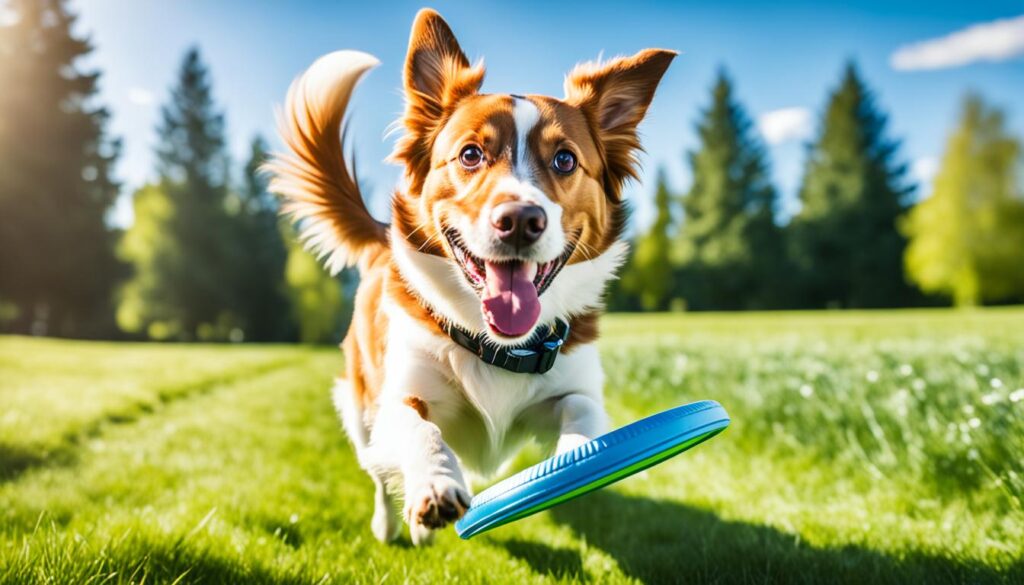
Remember to tailor the outing to your pet’s needs and physical capabilities. While some pets may enjoy longer hikes, others may prefer shorter walks or gentle strolls. Take breaks as needed to ensure they stay comfortable and hydrated.
Regular outings not only benefit your pet’s mood but also strengthen the bond between you and your furry companion. Sharing these experiences and spending quality time together can deepen your connection and create lasting memories.
So, make it a point to include regular outings in your pet’s routine. Whether it’s a leisurely stroll in the neighborhood or an exciting adventure in the great outdoors, these outings will contribute to your pet’s overall well-being and happiness.
Strategies to Prevent Behavioral Issues in Pets
Behavioral issues can be a common challenge for pet owners. To prevent and address such issues, we suggest implementing the following strategies:
Dealing with Separation Anxiety Through Activity
Separation anxiety is a common problem in pets and can be managed through engaging activities and exercise routines that help alleviate stress and anxiety when left alone. To address separation anxiety in pets, consider the following:
- Provide interactive toys and puzzle games that keep your pet mentally stimulated while you’re away.
- Establish a consistent routine with regular exercise and play sessions before leaving your pet alone.
- Consider using calming aids such as pheromone diffusers or anxiety wraps.
- Gradually increase the duration of your pet’s alone time to help them become more comfortable being on their own.
By incorporating these activities into your pet’s routine, you can help ease their separation anxiety and promote a sense of security and well-being.
Channeling Energy into Constructive Play
Destructive behaviors can often arise from excess energy or boredom in pets. To prevent destructive behaviors and channel their energy effectively, try the following:
- Engage your pet in constructive play activities that provide mental stimulation and physical exercise.
- Use interactive toys that require problem-solving skills and encourage your pet to focus their energy on a specific task.
- Consider enrolling your pet in obedience training classes where they can learn commands and engage in structured play with other dogs.
- Provide opportunities for your pet to explore their natural instincts, such as scent games or agility courses.
By engaging your pet in constructive play, you can provide an outlet for their energy and prevent behavioral issues in a positive and stimulating way.
Advanced Pet Wellness Advice for Aging Pets
As pets age, their health and wellness needs change. It is important to provide advanced care and make necessary adjustments to ensure their ongoing well-being. Here are some key tips for maintaining the health and wellness of senior pets:
1. Modify their exercise routine:
Senior pets may not have the same energy levels as younger animals. While regular exercise is still important, consider shorter and more frequent exercise sessions to prevent fatigue. Choose gentle activities that promote joint function and flexibility, such as leisurely walks or gentle stretching exercises.
2. Focus on nutrition:
Senior pets may have different nutritional requirements. Consult with your veterinarian to determine the best diet for your aging pet. Consider a diet that supports their changing nutritional needs, such as formulas that include joint-supporting ingredients or supplements. Providing a balanced and age-appropriate diet will help maintain their overall health.
3. Regular veterinary check-ups:
Frequent veterinary check-ups are crucial for senior pets. Regular examinations allow for early detection of age-related health issues and ensure timely interventions. Your veterinarian can provide guidance on age-specific health monitoring and recommend any necessary treatments or adjustments to your pet’s care routine.
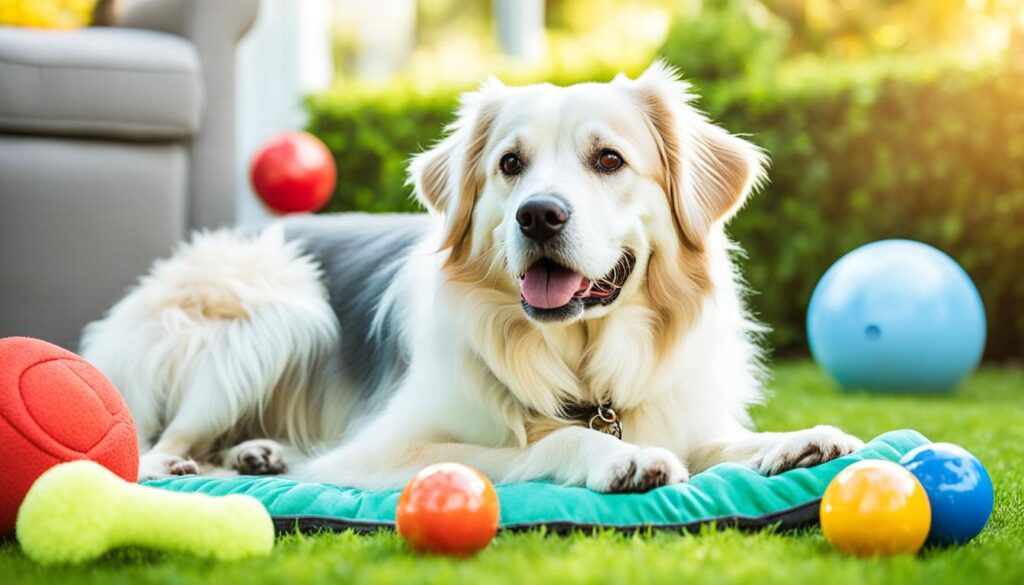
Make adjustments to your home environment to accommodate your senior pet’s changing needs. Provide comfortable bedding, easy access to food and water, and consider installing ramps or stairs to assist pets with mobility issues. Creating a safe and comfortable living space will help prevent accidents and promote overall well-being.
5. Cognitive stimulation:
Engage your senior pet in activities that promote mental stimulation. Puzzle toys and interactive games can help keep their minds sharp and prevent cognitive decline. Spend quality time engaging with your pet through gentle play sessions or training exercises that stimulate both their body and mind.
By following these advanced pet wellness tips, you can ensure that your aging pet enjoys a comfortable and fulfilling life. Providing the right care and making necessary adjustments will contribute to their overall health and happiness during their golden years.
Creating Lifelong Bonds Through Play and Exercise
Play and exercise are not only crucial for the health and wellness of our pets, but they also play a significant role in strengthening the bond between pets and their owners. When we engage in shared activities such as walks, runs, and play sessions with our pets, it fosters a sense of connection and mutual enjoyment.
Shared Activities to Strengthen Connection
One of the best ways to strengthen the bond with our pets is by participating in activities together. Taking regular walks or going on jogs with our furry companions not only provides physical exercise but also creates opportunities for quality time and bonding. Playing interactive games like fetch, tug-of-war, or hide-and-seek further deepens this connection.
Additionally, consider incorporating training sessions into your shared activities. Training exercises not only help reinforce basic commands but also enhance communication and understanding between pet and owner. These shared experiences promote trust, build a stronger relationship, and create lifelong memories.
The Emotional Benefits of Pet and Owner Exercise
Engaging in exercise and play with our pets provides several emotional benefits for both pet and owner. When we exercise together, endorphins are released, promoting a positive mood and reducing stress for both parties involved. This shared experience leads to increased feelings of joy, companionship, and overall well-being.
Regular exercise with our pets also improves communication and strengthens the bond of trust. Through consistent physical activity, pets learn to rely on their owners, while owners learn to understand their pet’s needs and cues. This mutual understanding and connection create a harmonious and fulfilling relationship.
By prioritizing play and exercise, we can create lifelong bonds with our pets, benefiting their health and overall well-being, and experiencing the joy and fulfillment that comes from sharing these activities together.
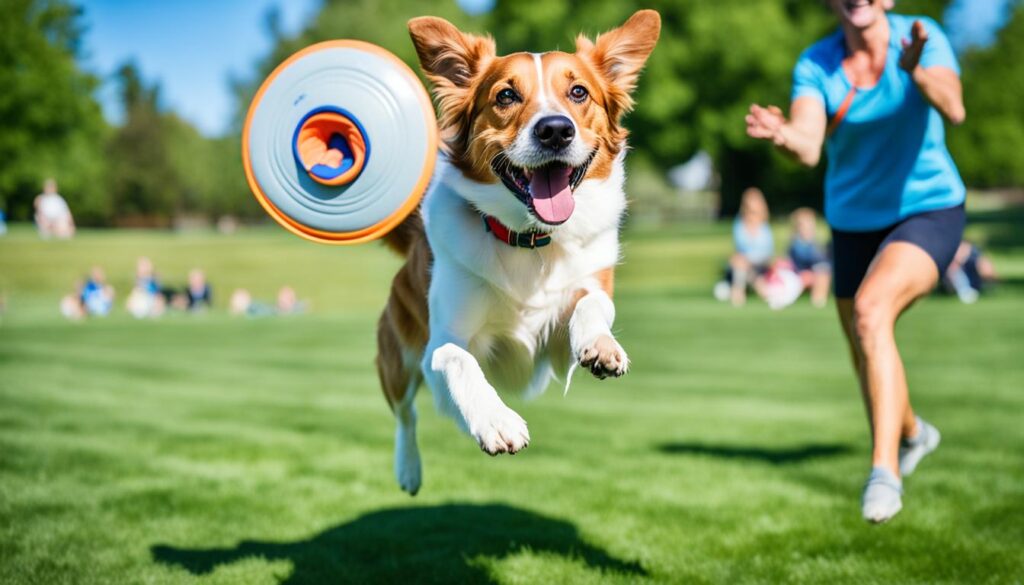
Pet Health Tips for Optimal Joint and Muscle Development
Ensuring the optimal joint and muscle development of our pets is crucial for their overall health and wellness. Regular exercise routines and targeted activities are key to promoting mobility, strength, and a balanced physique. By providing opportunities for our pets to engage in exercises and games that target their muscles and joints, we can help them achieve optimal joint and muscle health.
One effective way to promote joint and muscle development is through gentle stretching exercises. These exercises help improve flexibility and prevent stiffness in our pets. Incorporating activities like stretching after a warm-up routine or at the end of an exercise session can provide significant benefits.
Agility training is another excellent activity that can contribute to the development of strong muscles and joints. By setting up obstacle courses and encouraging our pets to conquer various challenges, we can enhance their coordination, balance, and overall physical fitness.
Giving our pets interactive toys and engaging them in games that encourage movement is also beneficial. Playing fetch, tug-of-war, or hide-and-seek not only provides mental stimulation but also helps exercise their muscles and joints.
Consulting with a veterinarian is essential to determine the appropriate exercises and therapies for our pets’ specific needs. They can guide us in tailoring exercise routines based on factors such as age, breed, and any existing health conditions our pets may have. By working closely with our veterinarians, we can ensure that our pets engage in activities that support their joint and muscle development while minimizing the risk of injury.
By prioritizing the joint and muscle health of our pets, we are taking a crucial step towards their overall well-being. Regular exercise routines, targeted activities, and professional guidance can help us ensure that our pets thrive physically and enjoy a high quality of life.
Maintaining Pet Wellness with Regular Veterinary Check-Ups
Regular veterinary check-ups are vital for maintaining the health and wellness of your pet. These check-ups not only allow for early detection of any potential health issues but also enable timely interventions and preventive care. It is crucial to prioritize these regular visits to ensure the best possible care for your beloved pet.
During a veterinary check-up, your pet will undergo a thorough physical examination, which helps identify any underlying health conditions or abnormalities. This examination includes assessing their weight, body condition, skin and coat health, dental health, and overall well-being. By addressing any emerging health concerns early on, you can prevent them from developing into more severe issues.
In addition to physical examinations, regular vaccinations are an important part of preventive pet care. Vaccines help protect your pet against common and potentially life-threatening diseases, ensuring their immune system stays strong and resilient. Your veterinarian will create a vaccination schedule specific to your pet’s needs based on their age, lifestyle, and any potential exposure risks.
Routine screenings, such as blood tests and urinalysis, are also essential components of regular veterinary check-ups. These screenings help identify any imbalances or abnormalities in your pet’s organ function, blood count, and overall health status. Detecting these issues early can significantly improve the effectiveness of treatment and prevent further complications.
By staying proactive about your pet’s health and following your veterinarian’s recommendations, you can help prevent potential health problems and ensure your pet’s overall well-being. Regular veterinary check-ups are a crucial aspect of preventive pet care, allowing you to address any emerging health concerns early and provide your pet with the best possible care.
Socializing Your Pet with Group Play Sessions
Socialization is an essential aspect of pet health and well-being. Group play sessions provide opportunities for pets to interact with other animals, improving their social skills and overall behavior. Dogs, in particular, are highly social animals and thrive when they have the chance to engage in playful interactions with their peers.
Engaging in Dog Parks and Community Spaces
Dog parks and community spaces are excellent environments for pets to engage in group play and socialize with other dogs and pet owners. These designated areas provide a safe and secure space for pets to run, exercise, and interact freely. They offer a range of activities and play structures that encourage exploration, socialization, and mental stimulation.
When visiting dog parks or community spaces, be sure to follow any rules and regulations set by the park authorities. Keep an eye on your pet at all times and ensure they play well with others. Remember to bring essentials such as water, poop bags, and toys to make the experience enjoyable for both you and your pet.
Group Activities for Pets: A Guide to Social Exercise
In addition to dog parks, there are various group activities available that promote social exercise for pets. Obedience classes, for example, allow pets to learn new skills while interacting with other dogs in a controlled environment. These classes not only provide mental stimulation but also improve their behavior and obedience.
Agility training is another popular group activity that involves navigating through obstacle courses. It challenges both pets and their owners, strengthening their bond and promoting physical fitness. Other options include organized playdates, where pets can socialize and play with a group of well-matched companions under supervision.
Engaging in group play sessions and social activities not only provides physical exercise but also contributes to a well-rounded and socially adept pet. It helps them develop proper social skills, reduces anxiety and aggression, and enhances their overall well-being. By incorporating group play opportunities into your pet’s routine, you are ensuring they lead a happy, healthy, and socially fulfilling life.
Pet Health and Wellness Tips Through Outdoor Adventures
Outdoor adventures provide a unique opportunity for pets to explore, exercise, and experience the wonders of nature. Whether it’s hiking, camping, or simply taking a walk in a scenic location, outdoor activities offer physical and mental stimulation for pets. It is important to ensure the safety of pets during outdoor adventures by following proper leash protocols, carrying essential supplies, and being mindful of their comfort and well-being.
Engaging in outdoor activities allows pets to fulfill their natural instincts and enjoy the benefits of fresh air and sunlight. The physical exercise obtained during outdoor adventures helps to maintain a healthy weight, strengthen muscles, and improve cardiovascular health. Additionally, exploring nature provides mental stimulation, promotes curiosity, and prevents boredom.
When embarking on outdoor adventures, it is crucial to prioritize the safety and well-being of pets. Here are some pet health and wellness tips to consider:
1. Proper leash protocols: Ensure pets are always on a leash and under control to prevent them from running off or getting into potentially dangerous situations. Follow local regulations and leash laws.
2. Essential supplies: Carry water, food, waste bags, and any necessary medications or first aid supplies for your pet. Provide regular water breaks to prevent dehydration.
3. Protective gear: Depending on the activity and environment, consider using protective gear such as boots, jackets, or sunscreen to shield pets from extreme temperatures, rough terrain, or harmful UV rays.
4. Be mindful of your pet’s limitations: Take into account your pet’s breed, age, and physical capabilities when planning outdoor adventures. Adjust the distance, intensity, and duration of activities accordingly to prevent exhaustion or injury.
Exploring nature with pets not only provides physical and mental benefits but also strengthens the bond between pets and their owners. It creates opportunities for shared experiences, quality time, and mutual enjoyment. Outdoor adventures allow pets to feel a sense of freedom, explore new scents and sights, and enjoy the beauty of the natural world.
Remember to consult with your veterinarian to ensure your pet is up to date on vaccinations, preventive medications, and to discuss any specific health considerations based on your pet’s individual needs.
Pet Health Information: Knowing the Signs of Exhaustion
Monitoring Your Pet During Exercise
Monitoring your pet’s health during exercise is crucial to ensure their well-being. Recognizing the signs of exhaustion is essential in preventing further strain on your pet. Some common signs of exhaustion to watch out for include:
- Excessive panting
- Difficulty breathing
- Excessive fatigue or lethargy
- Slowed movements
It’s important to take appropriate measures when you notice these signs. Provide your pet with rest breaks and ensure they have access to fresh water to stay hydrated. If your pet appears excessively fatigued or the signs persist, it’s advisable to consult with a veterinarian for further guidance.
Heatstroke and Dehydration: Prevention and Symptoms
Preventing heatstroke and dehydration is crucial for your pet’s health during exercise, especially in hot weather. Some preventative measures include:
- Avoid exercising your pet during the hottest part of the day
- Ensure there is ample shade available
- Provide access to clean and cool water at all times
- Consider using cooling mats or vests to help regulate your pet’s body temperature
Signs of heatstroke and dehydration in pets may include:
- Excessive panting and drooling
- Weakness or collapse
- Rapid heartbeat
- Dark urine or reduced urine output
- Vomiting or diarrhea
If you suspect that your pet is experiencing heatstroke or dehydration, it’s vital to seek immediate veterinary attention. Prompt treatment can greatly increase the chances of a full recovery.
Being aware of the signs of exhaustion, monitoring your pet during exercise, and taking precautions to prevent heatstroke and dehydration are essential for maintaining your pet’s health and well-being. By prioritizing your pet’s safety and providing necessary rest and hydration, you can ensure that they can enjoy exercise without compromising their health.
Conclusion
In conclusion, regular play and exercise are essential for the overall health and wellness of your pets. These activities provide numerous benefits, from physical fitness to mental stimulation and emotional well-being. By following our essential pet care tips, you can ensure the optimal health and longevity of your furry companions.
Remember to schedule regular veterinary check-ups to monitor your pet’s health and address any potential issues early on. Along with that, develop appropriate exercise routines tailored to your pet’s specific needs and provide a balanced and nutritious diet to support their active lifestyle.
Additionally, prioritize socialization and outdoor adventures to enhance your pet’s well-being. Engaging in group play sessions, exploring nature, and monitoring your pet’s health during exercise contribute to their overall happiness and fulfillment.
By making play and exercise a priority in your pet’s life, you are creating a happy and healthy companion for years to come. Remember, pet health and wellness are in your hands, and by taking the necessary steps, you can provide the best care for your beloved pets.
FAQ
What are the benefits of regular play and exercise for pets?
Regular play and exercise provide numerous benefits for pets, including keeping them fit, maintaining a healthy weight, promoting a healthy digestive and circulatory system, lowering blood pressure, preventing behavioral problems, and improving mood and overall well-being.
How does play contribute to pet wellness?
Play provides physical exercise, mental stimulation, and emotional well-being for pets. Engaging in interactive games helps keep their minds sharp, promotes cognitive development, and strengthens the bond between pets and their owners.
How can I combat pet obesity through exercise routines?
Regular exercise is key to combating pet obesity and maintaining a healthy weight. By following an exercise routine tailored to your pet’s needs, you can help them shed excess pounds and prevent related health problems.
What are some essential pet care tips for a healthy pet?
Daily exercise is important for all pets, and understanding the exercise requirements of your pet’s breed is crucial. Additionally, providing a balanced and nutritious diet that supports an active lifestyle is essential. Regular veterinary check-ups are also vital for maintaining pet wellness.
How can regular outings improve my pet’s mood?
Regular outings and trips outdoors provide mental stimulation and enrichment for pets. Exploring new environments, sights, smells, and sounds help reduce stress, anxiety, and boredom, leading to improved mood and overall well-being.
What strategies can I implement to prevent behavioral issues in my pet?
To prevent behavioral issues, you can engage in interactive activities to help alleviate separation anxiety, channel your pet’s energy into constructive play, and provide mental stimulation through interactive toys, puzzle games, and obedience training techniques.
What are some advanced wellness strategies for aging pets?
Aging pets have changing health and wellness needs. Advanced wellness strategies for aging pets include modifying their exercise routine, adjusting their diet, and scheduling regular veterinary check-ups to monitor their health and address any age-related issues effectively.
How does play and exercise strengthen the bond between pets and their owners?
Engaging in shared activities such as walks, runs, and play sessions fosters a sense of connection and mutual enjoyment, leading to increased trust, improved communication, and heightened feelings of joy and companionship between pets and their owners.
How can I ensure optimal joint and muscle development in my pet?
Optimal joint and muscle development in pets can be achieved through regular exercise routines and activities that promote mobility and strength. Gentle stretching exercises, agility training, and games that encourage movement can help target their muscles and joints.
Why are regular veterinary check-ups important for maintaining pet wellness?
Regular veterinary check-ups allow for early detection of any health issues, ensuring timely interventions and preventive care. Thorough physical examinations, vaccinations, and routine screenings are essential for monitoring your pet’s health and preventing potential health problems.
How can group play sessions contribute to a socially adept pet?
Group play sessions provide opportunities for pets to interact with other animals, improving their social skills and overall behavior. Engaging in dog parks, community spaces, and structured group activities like obedience classes and playdates helps pets develop into well-rounded and socially adept companions.
How can outdoor adventures contribute to pet health and wellness?
Outdoor adventures provide physical and mental stimulation for pets. Whether it’s hiking, camping, or simply taking a walk in a scenic location, outdoor activities offer opportunities for exploration, exercise, and experiencing the wonders of nature.
How can I monitor my pet’s health during exercise?
It is crucial to recognize the signs of exhaustion in pets, such as excessive panting, difficulty breathing, and excessive fatigue. Monitoring hydration levels, providing regular water breaks, and avoiding exercise in extreme heat can help prevent heatstroke and dehydration. It’s important to consult with a veterinarian for specific guidelines on exercising in different weather conditions.

